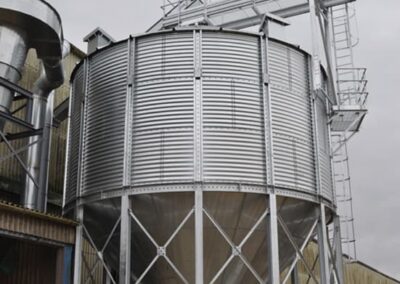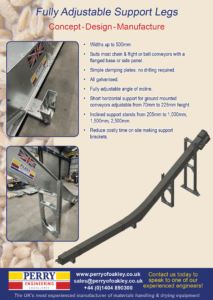Hopper Bottom Silos
Perry have introduced an extensive range of hopper bottomed bins & flat silos. Designed by a team of specialists with over 50 years of global silo experience the silos are manufactured on state of the art equipment and can be specified to meet either ANSI or Eurocode standards depending on the destination country
Key Points
- Hopper bottom silo capacities from 35 to 3,000 tonnes based on wheat at 750kg/m³.
- Supplied flat pack for bolted construction onsite.
- 45 and 60 degree hoppers available.
- Diameters from 3m to 13m.
- Custom diameters available to suit existing bases if replacing an end of life silo.
- Galvanised, stainless, mild steel & painted options available.
- Bin slides – manual, motorised & electro pneumatic.
- Outlet sizes are 300mm, 400mm or 600mm depending on application.
- Special silos available to suit customer’s applications.
Scope of Supply
In addition to the standard silo range, within the scope of supply will be:
- Complete aeration systems (fans, perforated floors, etc.).
- Monitoring systems (portable or with computers) for grain moisture, temperature & CO2.
- Unloading equipment.
- Walkways & catwalks – the catwalk system is modular to be able to adapt to all types of conveyor loads and to any design of the plant. Standard catwalk widths between 1m and 3.6m, including a 1.1m double handrail. Custom sizes are available on request.
- Towers and structures (supporting columns, work towers, structures for loading silos of trucks / trains).
Go to Silo Accessories for more information
*All photos are from previous Perry of Oakley Ltd installations.
Contact us today to discuss your Storage requirements
Call us on +44 (0)1404 890300 or email [email protected]
Everything You Should Know About Grain Sentry Fire Detection
With over 40 years of experience, Fire Shield Systems offer a holistic approach to fire protection encompassing design, installation, maintenance and training.
Which Type of Grain Dryer Should I Buy?
With over 70 years of experience, Perry of Oakley Ltd. are the UK’s most experienced manufacturer of materials drying and handling equipment. Our Dryers are relied on to manage a variety of crops, and in different climates all over the world.
Why Buy a Perry Mistral Grain Dryer?
More efficient drying and handling equipment can be used to save medium sized farms time and money while improving satisfaction within the workplace.








































